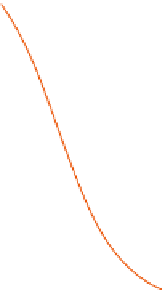Biomedical Engineering Reference
In-Depth Information
frequency (rad s
−
1
)
0.1
0.39
1
3.9
10
39
100
10
2
10
1
Gel point
c
g
=
12.5 g/L
tan
δ
=
2.4
G
'
<
G
“
10
0
G
'
>
G
“
10
−
1
10
0
10
1
c
(g/L)
Winter
-
Chambon criteria applied to PVC gelation with concentration as gelation parameter
(concentration at the gel point c
g
= 12.5 g L
−
1
, angular frequencies 0.1, 0.39, 1, 3.9, 10, 39,
100 rad s
−
1
). Adapted with permission from Li et al.(
1997
) © 1997 American Chemical Society.
Figure 3.9
Working on PVC (poly(vinylchloride)) with various molecular masses in the presence
of the plasticizer DOP (bis(2-ethylhexyl) phthalate), Li and Aoki (
1997
) studied the
transition from sol to gel by applying these criteria. They took polymer concentration c as
the parameter representing the change in connectivity of the solution. The exponent of
the power law for G
0
and G
00
, n = 0.75, at the gel point indicates that, as shown in
Figure 3.9
, at a concentration of 12.5 g L
−
1
the medium is viscoelastic with G
00
>G
0
(as
= 2.4, G
00
= 2.4G
0
). The concentration at which G
0
overtakes G
00
tan
δ
at the lowest
available frequency (0.1 rad s
−
1
), tan
δ
= 1, corresponds to a higher concentration (close
to 15 g L
−
1
from
Figure 3.9
).
It is dif
cult to de
ne the state in which the system should be classi
ed in this
ning the medium as a gel while G
00
intermediate range of concentrations. De
is still
higher than G
0
at any frequency investigated seems to contradict the usual de
nitions of a
solid-like material. The mechanism of gelation for PVC is related to formation of
crystallites in the syndiotactic polymer sequences, but the molecular structure of the
crystallites is not determined. The authors assume that PVC clusters form before the gel
point and that gelation corresponds to percolation of the clusters, but there is no direct
evidence that, at their gel point, the clusters are indeed connected. The authors found
gelation concentration to be inversely proportional to the molecular mass of the linear
chains, and assumed that percolation between clusters is favoured by longer chains. Li
et al. (
1997
), in looking for scaling exponents of percolation, interpreted the zero-
frequency viscosity of the gelling solution and the shear modulus versus distance to
the gel point as a function of
ε
−
cult to establish
a simple relationship between c and p (Aoki and Kakiuchi,
1998
). te Nijenhuis and
Winter (
1989
) studied PVC gelation with various plasticizers and found the gel point
=(c
c
gel
)/c
gel
, although in general it is dif






























































Search WWH ::

Custom Search